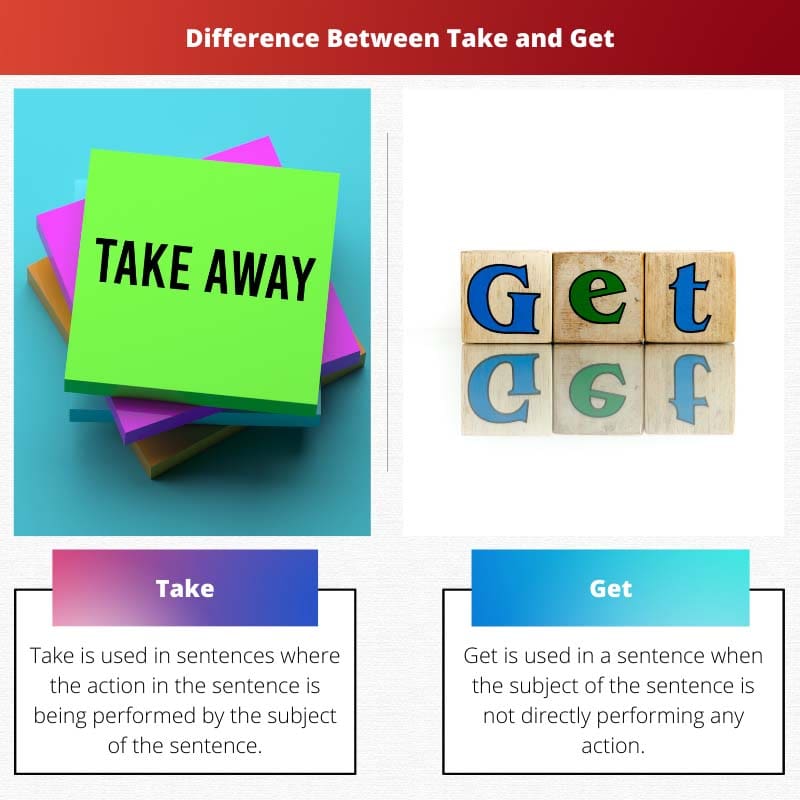There are many words in English that may have similar meanings or ideas in a particular context but can change the complete meaning of the sentence in which they are used.
Thus although certain words may appear interchangeable, the changing of words can result in the sentence conveying a completely different meaning.
Key Takeaways
- “Take” implies an active effort or intention to acquire something, while “get” can indicate passive acquisition.
- “Take” can describe physical and abstract actions, whereas “get” primarily refers to obtaining or receiving something.
- “Take” is used with a direct object, while “get” may require a preposition for clarity.
Take vs Get
‘Take’ is a verb that denotes the action of acquiring or receiving something, or moving something from one place to another. ‘Get’, on the other hand, is a versatile verb used to denote the action of receiving, obtaining, or becoming.

Take is used in sentences where the subject of the sentence is performing the action in the sentence.
Thus it indicates the direct performance of an action, which is being completed by the subject of the sentence. Some examples of the usage of Taking are, Take the book, etc.
Get is used in a sentence when the subject of the sentence is not directly performing any action rather they are a part of the action as the receiver in the completion of the action.
Thus in such cases, the subject of the sentence is passive, and the action is being performed by the subject.
Comparison Table
| Parameters of Comparison | Take | Get |
|---|---|---|
| State of the Subject | The subject is active in the sentence | The subject is passive in the sentence |
| Usage | Used when the subject is performing the action | Used when the action is being performed for the subject |
| Completion of the action | The action of the sentence is completed directly by the subject | The action of the sentence is completed when the subject receives the object |
| Object state | The object’s state can change in terms of ownership or location | The object’s state remains the same |
| Results of the action | The subject changes the state of the object | The object changes the state of the subject |
What is Take?
Take is an English action word used to indicate an actor’s performance in the sentence. The action is primarily initiated and completed by the subject of the sentence.
As the subject of the sentence directly completes the action, the subject is directly involved in the sentence and thus is in an active state.
Thus take indicates that the doer of the sentence will initiate and complete the action.
The object of the sentence is directly placed after taking, but in a few cases, an article may be placed in front of the object.
Thus to use Take in a sentence, the subject has to be directly involved in the action of acquiring the object.
Thus the subject and object are directly involved in the completion of the action in the sentence.
Take is used in three situations, such as when the subject actively acquires the object, changes the location of the object, or acquires the object but without permission.
Thus in either of the cases, the state of the object is directly changed by the doer of the sentence in terms of its location and terms of the ownership of the object.

What is Get?
Get is an action word that indicates a change in the state of the subject with respect to the object of the sentence.
The subject, in such cases, is not the active performer of the action indicated in the sentence.
As the subject is not the active doer of the action in the sentence, the subject is present in a passive state in the sentence.
The subject’s state is changed due to another parameter of the sentence responsible for the initiation and completion of the action.
The action in the sentence is completed when the subject of the sentence receives the object of the sentence.
The object is placed after getting, but in most cases, an article is placed before the object of the sentence.
Get is used in three instances when the subject directly receives the object, when the state of the subject changes due to the object, or when the subject acquires the object indirectly.
In either of the cases, the object is directly responsible for the change in the state of the subject in the sentence.
As the subject is in the passive state, a doer has to be included in the sentence to perform the action described in the sentence.

Main Differences Between Take and Get
- When Take is used, the subject is active in the sentence, when Get is used, the subject is passive in the sentence.
- Take is used to indicate that the subject is performing the action. Get is used when the action is being performed for the subject.
- In the case of Take, the action is directly completed by the subject. In the case of Get, the action is completed when the subject receives the object.
- In a sentence with Take, the object’s state can either change in terms of location or ownership, whereas in a sentence with Get, the object’s state stays the same.
- In a sentence with Take, the subject changes the state of the object. In a sentence with Get, the object changes the state of the subject.


The article is a comprehensive guide on the contrast and varied applications of ‘take’ and ‘get’. It offers an insightful analysis of their usage.
The detailed comparison of the usage of ‘take’ and ‘get’ in different contexts greatly contributes to understanding their nuanced differences.
The concept of ‘Take’ and ‘Get’ usage is well-explained, and the examples provided enhance the clarity of understanding.
This is an interesting article that explains the subtle differences between similar words.
The explanation of ‘take’ and ‘get’ is very clear and concise. Great work on detailing the usage of these words.
I couldn’t agree more. The article provides a comprehensive understanding of the context in which these words are used.
I appreciate the thorough explanation of ‘take’ and ‘get’ along with the main differences. This clarifies many doubts related to their usage.
The article does a fantastic job of elucidating the subtle differences between ‘take’ and ‘get’. The real-world examples are particularly insightful.
Absolutely, the discussions on ‘take’ and ‘get’ are elucidating indeed. The examples serve as practical illustrations of the points made in the article.
The article’s explanation on the concept of ‘taking’ and ‘getting’ is exceptionally clear and informative. It definitely enhances the understanding of these words.
The comparison table is quite helpful in understanding the different parameters of comparison. Thank you for the insightful article.